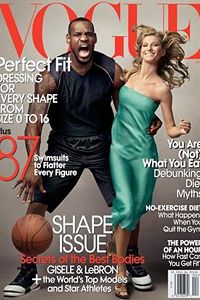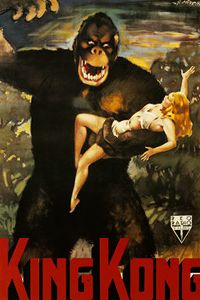If you've ever seen photos of LeBron James away from the basketball court, it's obvious he takes great pride in his appearance.
In fact, he's widely considered one of the best-dressed guys in the NBA -- perhaps even in all of sports. LeBron's mentor is Jay-Z, the rapper-turned-mogul who dropped throwbacks for Armani suits years ago.

Vogue
LeBron making the cover is a good thing. But the pose, not so much.
In case you haven't seen the cover, LeBron has Gisele in one hand and a basketball in the other. LeBron is dressed in basketball gear, with his muscles flexing, tattoos showing and bared teeth. Gisele, on the other hand, is wearing a gorgeous slim-fitting dress, and smiling.
She looks like she's on her way to something fashionable and exciting. He looks like he's on his way to a pickup game for serial killers.Now, maybe the point was to show the contrast between brawn and beauty, masculinity versus femininity, strength versus grace. But Vogue's quest to highlight the differences between superstar athletes and supermodels only successfully reinforces the animalistic stereotypes frequently associated with black athletes.
A black athlete being reduced to a savage is, sadly, nothing new. But this cover gave you the double-bonus of having LeBron and Gisele strike poses that others in the blogosphere have noted draw a striking resemblance to the racially charged image of King Kong enveloping his very fair-skinned lady love interest.
LeBron is just the third male ever to appear on Vogue's cover, but it's hard to believe Vogue would have made Brett Favre, Steve Nash or even David Beckham strike his best beast pose. And even if Vogue had, it wouldn't carry the same racial undertones as having a fear-inducing black man paired with a dainty damsel.
Too often, black athletes are presented as angry, overly aggressive and overly sexual. Or sometimes, they're just plain emasculated.
The examples of this are endless. The 2002 Sports Illustrated cover that featured Charles Barkley chained like a slave. Ricky Williams wearing a wedding dress on an ESPN The Magazine cover in 1999. And while it didn't appear in a magazine, the Terrell Owens-Nicolette Sheridan intimate-encounter tease for "Monday Night Football" gave viewers a sexualized image of a black man.
In fact, the shirtless black male athlete cover is pretty much a staple, reinforcing the idea that black athletes were blessed with physical characteristics, not mental ones.
"Society has become more civilized, more humane over 150 years or so, and that's all fine and good," said Dr. John Hoberman, a University of Texas professor and author of the controversial book "Darwin's Athletes: How Sports Has Damaged Black America and Preserved the Myth of Race." "But what happens to these fundamentally racist ideas over a period of time? Do they simply disappear?"
Having studied the images of black athletes for years, Hoberman contends that the images of black athletes presented today are no better than the ones offered centuries ago. And if it matters to you, Hoberman is white.

AllPosters.com
See any similarities with the Vogue cover above?
But we don't even have to dip back to the 19th century to see how images of black athletes have affected how we think and thus how we view sports. In 1994, Jack Nicklaus said there weren't more African-Americans in golf because "blacks have different muscles that react in different ways."
And that backward thinking isn't limited to whites, either. Former ESPN NFL analyst Michael Irvin channeled his inner Jimmy the Greek when attempting to explain Tony Romo's abilities. Irvin surmised that Romo was good because his "great, great, great, great grandma pulled one of them studs up outta the barn [and said], 'Come here for a second.'"
It's like Barack Obama said in his much-talked about speech on race Tuesday. We know so little about one another. Even scarier, we know even less about the fallout of racist history.
"It's a great, great issue that Vogue has made trivial," Hoberman said. "It's exploitative. It's going for the primitive, racial emotion as opposed to something tasteful and edifying."
Vogue deserves criticism, but more blame should go to LeBron and other black athletes, who need to exercise stricter control of their images. If LeBron is brave enough to wear a Yankees cap at an Indians playoff game, picking up a history book and educating himself shouldn't cause a strain.
This isn't to say Vogue's cover deserves to be in the same category as Golfweek magazine, which featured a noose on its front during the Kelly Tilghman-Tiger Woods flap. But as always, it's important to question who was in the room when the cover decisions were made.
As it is, LeBron was the first African-American male to grace Vogue's cover. Too bad it will be memorable for the wrong reasons.
Jemele Hill can be reached at jemeleespn@gmail.com.
No comments:
Post a Comment